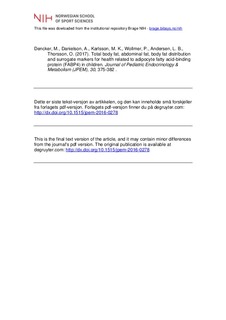| dc.description.abstract | Background: The aim of the study was to assess possible relationships between adipocyte fatty acid-binding protein (FABP4) and total body fat (TBF), abdominal fat, body fat distribution, aerobic fitness, blood pressure, cardiac dimensions and the increase in body fat over 2 years in a community sample of children. Methods: A cross-sectional study was used in a community sample of 170 (92 boys and 78 girls) children aged 8–11 years. TBF and abdominal fat (AFM) were measured by dual-energy X-ray absorptiometry (DXA). TBF was also expressed as percentage of total body mass (BF%), and body fat distribution was calculated as AFM/TBF. Maximal oxygen uptake (VO2PEAK) was assessed by indirect calorimetry during a maximal exercise test and scaled to body mass. Systolic and diastolic blood pressure (SBP and DBP) and pulse pressure (PP) were measured. Echocardiography was performed. Left atrial (LA) size was measured, and left ventricular mass (LVM) was calculated. A follow-up DXA scan was available in 152 children (84 boys and 68 girls). Frozen serum samples were analyzed for FABP4. Results: Partial correlations, with adjustment for sex, between FABP4 vs. ln TBF, ln BF%, ln AFM, AFM/TBF and VO2PEAK were (r=0.69, 0.68, 0.69, 0.49 and −0.39, p<0.05 for all). Moreover, SBP, PP, LVM and LA were also weakly correlated with FABP4 (r=0.23, 0.22, 0.28 and 0.21, p<0.05 for all). Correlations between FABP4 vs. increase in TBF and AFM over 2 years were 0.29 and 0.26, p<0.05, for both. (Increase in percent body fat or change in fat distribution were not correlated.)
Conclusions: Findings from this community-based cohort of young children show that increased body fat and abdominal fat, more abdominal body fat distribution, low fitness, more LVM and increased LA, increased SBP and PP were all associated with increased levels of FABP4. Increase in TBF and abdominal fat over 2 years were also associated with increased levels of FABP4. | nb_NO |
